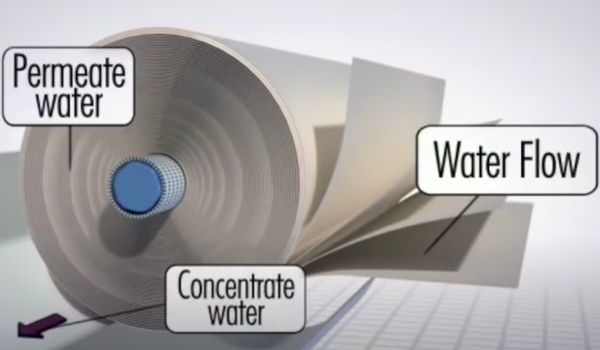A well-maintained reverse osmosis filter will improve your drinking water quality for years to come. But replacing the filters is a little more challenging than changing the carbon cartridges in filtration pitchers.
Still, it’s a simple process that requires no plumbing skills or technical expertise. All it takes is your patience and our know-how.
Key Takeaways:
- Regular maintenance of a reverse osmosis filter ensures better water quality.
- Signs a filter needs replacement:
- Reduced water flow
- Altered taste or odor
- Cloudiness in water
- High TDS reading.
- Filter lifespan:
- Pre-filter: 6-12 months
- Post-filter: 12-24 months
- Membrane: 2-3 years
- Risks of delayed filter replacement: decreased filtration, bacterial growth.
- Most filter replacements are DIY, but professionals are available if needed.
- Useful replacement tips: use pliers for tight spots, check expiration, follow guidelines.
Let’s review how to replace the filters in a reverse osmosis system.
Recognizing the Telltale Signs of a Reverse Osmosis Filter in Need of Replacement

Maintaining the pristine quality of your water hinges on knowing precisely when to replace your reverse osmosis filter. Over time, these filters can become congested with impurities and lose their efficacy. As an expert in this field, I will guide you through the key indicators that it’s time for a filter change:
- Decreased Water Flow: If you’ve noticed a significant drop in water flow from your faucet or dispenser, it’s likely due to a clogged filter that requires immediate replacement.
- Unpleasant Taste or Odor: One of the remarkable advantages of utilizing a reverse osmosis system is its ability to eliminate any unsavory tastes or odors from tap water. However, if you start detecting an unusual taste or odor in your filtered water, it serves as an unmistakable sign that your filter needs changing.
- Cloudy Water: A properly functioning reverse osmosis system should consistently produce crystal-clear water. Should you observe cloudiness or particles floating about in your filtered water, rest assured that it’s time to bid farewell to your worn-out filter.
- Elevated Total Dissolved Solids (TDS) Reading: TDS refers to minerals and other dissolved substances present in water. An elevated TDS reading indicates that the filtration process is no longer effectively removing these impurities—a clear indication that a new filter is necessary.

The lifespan of a reverse osmosis filter varies depending on several factors such as usage patterns, feedwater quality, and maintenance practices employed by homeowners like yourself. Generally speaking though, most filters typically last between six months and two years before requiring replacement.
It cannot be stressed enough how crucial timely replacements are—neglecting them poses risks not only to health but also system performance:
- Bacterial Growth: Neglected old filters can quickly become breeding grounds for bacteria. Failing to replace them regularly can lead to contamination of your drinking water, potentially causing health issues.
- Diminished Filtration Efficiency: As filters age, their ability to effectively remove contaminants from tap water gradually diminishes. This compromises the overall quality of your filtered water and undermines the very purpose of having a reverse osmosis system in place.
By remaining vigilant and recognizing these telltale signs, you can ensure that your reverse osmosis filter consistently operates at its peak performance level—delivering clean and safe drinking water straight into your glass. In our next section, we will delve into selecting the perfect replacement filter for your specific system needs.
The Expert’s Guide to Choosing the Perfect Reverse Osmosis Filter

Choosing the perfect reverse osmosis filter is crucial for optimal performance and crystal-clear water. Let me guide you through key factors to consider when selecting a new filter.
- Assess Your Water Quality: Before doing anything, it’s essential to test your water quality. This will help identify specific water contaminants that need to be eliminated.
- Determine Your Filtration Needs: Different reverse osmosis filters are designed to target various impurities present in water. Consider whether you require a filter that removes chlorine, heavy metals, bacteria, or other contaminants based on your local water conditions.
- Ensure Compatibility: It’s important to check if the replacement filter is compatible with your existing reverse osmosis system. Look for filters specifically designed for your model or brand.
- Lifespan and Maintenance Evaluation: Evaluate how frequently replacement filters should be changed and factor in any additional maintenance requirements they may have. Some filters may necessitate more frequent replacements than others.
- Strike a Balance Between Cost-Effectiveness and Quality: While comparing prices of different brands and models, take into account their lifespan and filtration capabilities as well. Striking a balance between cost-effectiveness and high-quality filtration is paramount.
- Is it time for a new system: if so, have a look at our top recommended models.
Recommended Brands and Models:
- Waterdrop: A trusted brand offering various options suitable for different filtration needs.
- Ispring: Renowned for their durability and efficiency in removing impurities.
- APEC Water Systems Filters: Highly rated due to their superior contaminant removal capabilities.
By carefully considering these factors like an expert would do, you can confidently choose a reverse osmosis filter that perfectly aligns with your specific needs while providing clean and safe drinking water for you and your loved ones.
Step-by-Step Guide to Replacing Your Reverse Osmosis Filter
All reverse osmosis filters are different, so always refer to the instructions in the owner’s manual for how to change reverse osmosis membranes. But here’s the general procedure:
Gather Supplies
If you have the tools and supplies you’ll need handy, you can wrap up an RO membrane change in less than a half-hour.
- Gather the necessary tools and materials: Before diving into the replacement process, ensure that you have all the essential tools at hand. You’ll need a new reverse osmosis filter, pliers or a wrench for disconnecting connections, a towel or bucket to catch any spills, and Teflon tape for sealing connections.
- Turn off the water supply: Locate the shut-off valve connected to your reverse osmosis system and turn it off completely. This crucial step prevents any water flow during the replacement procedure.
- Release pressure from the system: Open one of your faucets linked to the RO system to release built-up pressure within it. This precautionary measure ensures that excess pressure doesn’t cause leaks when removing components.
- Remove old filters with finesse: Begin by identifying which specific filter needs replacing based on its location in your RO setup (usually labeled). Use pliers or a wrench to gently loosen and remove any connections holding the old filter in place.
- Dispose of old filters responsibly: Once removed, dispose of old filters following local regulations for hazardous waste disposal if applicable in your area.
- Prepare new filter for installation with care: Take out your pristine reverse osmosis filter from its packaging while keeping it covered until ready for installation—this safeguards against contamination by dirt or debris.
- Install new filters like an expert: Delicately insert each end of the new filter into their respective housing slots until they are securely seated inside without exerting excessive force that could damage seals or lead to future leaks during operation.
- Secure connections with precision: Use pliers or a wrench to tighten the connections on both ends of the new filter, ensuring they are snug but not overly tightened.
- Check for leaks like a pro: Turn on the water supply and meticulously inspect for any signs of leaks around the newly installed filter. If you notice any leaks, promptly turn off the water supply and recheck your connections.
- Run a flush cycle to perfection: After successfully installing the new filter without any leaks, initiate a flush cycle by turning on your reverse osmosis system and allowing it to operate for several minutes. This process effectively eliminates air pockets or loose debris that may have accumulated during installation.
- Test water quality like an expert evaluator: Once the flush cycle is complete, assess your water quality using an appropriate testing kit or send a sample to a certified laboratory if desired. This step guarantees that your new filter is efficiently removing impurities from your precious drinking water.
- Set reminders for future replacements like clockwork: To stay ahead of regular maintenance, set reminders in your calendar or phone based on manufacturer recommendations (typically every 6-12 months) so that you never miss another crucial replacement date again.
By following these expert instructions diligently, you can effortlessly replace your reverse osmosis filter and enjoy consistently clean and purified drinking water in the comfort of your own home.
Frequently Asked Questions About Replacing Reverse Osmosis Filters

As a reverse osmosis filter expert, I know you have questions about replacing your filter. Here, I’ll list the most common questions and concerns to provide you with a smooth experience with your RO system.
- How can I tell if my reverse osmosis filter needs to be replaced?
There are several signs that indicate it’s time to replace your reverse osmosis filter:
- Decreased water flow
- Unpleasant taste or odor
- Cloudy or discolored water
- Elevated Total Dissolved Solids (TDS) reading
- How often should I change my reverse osmosis filter?
The lifespan of a reverse osmosis filter can vary, but as a general guideline, it is recommended to replace the pre-filter every 6-12 months and the post-filter every 12-24 months. The membrane typically lasts around 2-3 years before needing replacement.
- What are the risks of not replacing my reverse osmosis filter on time?
Not replacing your filters on time can lead to reduced filtration efficiency, potential bacterial growth, and compromised water quality. It’s important to stay on top of regular replacements to ensure clean and safe drinking water.
- Can I install new reverse osmosis filters myself, or should I seek professional help?
Filter replacement for a reverse osmosis system is typically a straightforward process that can be done by homeowners. However, if you are unsure or uncomfortable with DIY tasks, it’s always best to consult a professional to ensure proper installation and maintenance.
- Are there any tips for dealing with common problems during the filter replacement process?
Here are a few tips to help you navigate common problems during the filter replacement process:
- Use pliers for tight connections
- Check the expiration date on the filter
- Follow manufacturer instructions
- Where can I find professional assistance if needed?
Final Thoughts
Reverse osmosis filters require occasional TLC, but like any investment, if you take good care of a water filter, it will take good care of you. We recommend keeping this guide and replacement filters on hand, so you’ll always be maintenance-ready.
 117 people found this helpful. Was this guide helpful to you?
117 people found this helpful. Was this guide helpful to you? 

